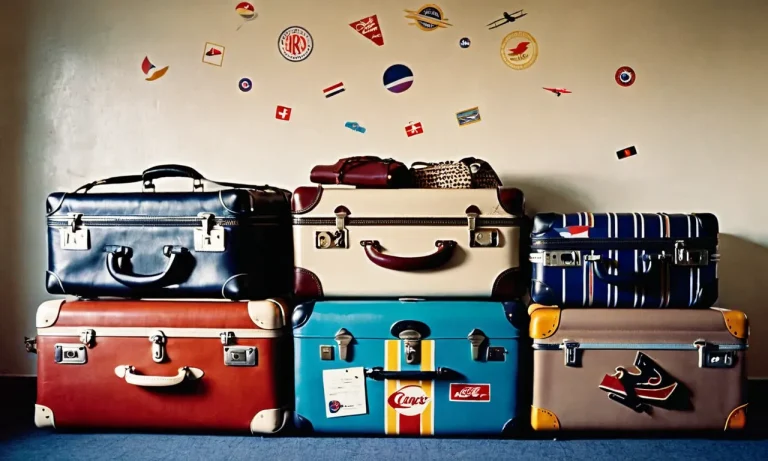Sand Dollars In Myrtle Beach: What You Need To Know
Myrtle Beach is a popular vacation destination located along South Carolina’s Grand Strand. Miles of sandy beaches make it a beachcomber’s paradise. One of the many treasures you may come across during your beach strolls are sand dollars.
If you’re short on time, here’s a quick answer: Sand dollars are a type of flattened sea urchin commonly found washed up along Myrtle Beach shores. While it’s illegal to collect live sand dollars, you may take home properly cleaned dead specimens as souvenirs.
In this comprehensive guide, we’ll cover everything you need to know about sand dollars in Myrtle Beach, including what they are, where to find them, laws regarding collecting them, how to tell if they’re alive or dead, cleaning tips, and creative ideas for using them in crafts and décor.
What Exactly Are Sand Dollars?
When strolling along the shores of Myrtle Beach, you may come across these fascinating marine creatures known as sand dollars. But what exactly are they? Let’s dive into some basic facts and characteristics of sand dollars to help you understand these unique creatures better.
Basic Facts and Characteristics
Sand dollars are actually a type of sea urchin that belong to the class Echinoidea. They are flat and round in shape, resembling a small coin, hence their name. These creatures are typically found in sandy or muddy ocean floors, where they use their spines to burrow and move around.
One of the most distinctive features of sand dollars is their exoskeleton, which is covered in a series of tiny, interlocking plates. These plates are often white or gray in color, providing excellent camouflage in the sandy environment.
However, it’s worth noting that live sand dollars can exhibit a range of colors, including vibrant shades of purple, green, and red.
Another interesting characteristic of sand dollars is their feeding mechanism. They are filter feeders, meaning they use their spines and tube feet to capture tiny particles of food in the water. These particles, such as plankton and detritus, are then transported to the sand dollar’s mouth located on its underside.
Difference Between Live and Dead Specimens
It’s important to differentiate between live and dead sand dollars when you come across them on the beach. Live sand dollars are covered in a fine layer of cilia, which helps them move and filter feed. They may also have visible spines and can still be slightly mobile.
On the other hand, dead sand dollars have a bleached appearance and lack the cilia and spines. They are often found washed up on the shore and have a fragile, papery texture. Collecting dead sand dollars is legal, but it’s advised to leave live ones in their natural habitat to ensure the survival of the species.
Understanding the basic facts and characteristics of sand dollars will enhance your beachcombing experience in Myrtle Beach. Whether you stumble upon a live or dead specimen, take a moment to appreciate the beauty and intricacy of these fascinating creatures.
Where to Find Sand Dollars in Myrtle Beach
1. North Myrtle Beach
If you’re looking for a great spot to find sand dollars in Myrtle Beach, North Myrtle Beach is a must-visit destination. Located just a short drive away from the heart of Myrtle Beach, North Myrtle Beach offers miles of pristine coastline where you can search for these beautiful treasures.
One of the best times to find sand dollars at North Myrtle Beach is during low tide. As the water recedes, it reveals a wide stretch of sandy beach where sand dollars often wash up. Keep an eye out for small, circular depressions in the sand, as these are often a sign that sand dollars are nearby.
2. Myrtle Beach State Park
Another fantastic location for sand dollar hunting in Myrtle Beach is the Myrtle Beach State Park. This scenic state park offers not only beautiful beaches but also nature trails and picnic areas, making it a great place to spend the day with your family.
When searching for sand dollars at Myrtle Beach State Park, head to the areas where the waves break and gently wash ashore. These spots are often where sand dollars can be found. Remember to be gentle when handling the sand dollars and avoid removing live ones from the water.
3. Huntington Beach State Park
Huntington Beach State Park is another excellent destination for finding sand dollars in Myrtle Beach. This beautiful park features a diverse range of habitats, including marshes, forests, and stunning beaches.
One of the best places to find sand dollars at Huntington Beach State Park is near the jetties. These rocky structures often create pockets where sand dollars can accumulate. Take a leisurely stroll along the beach and keep an eye out for these unique treasures.
Remember, when searching for sand dollars, it’s important to be respectful of the environment and the creatures that call the beach their home. Avoid removing live sand dollars from the water, as they play a crucial role in the ecosystem.
Instead, admire them in their natural habitat and take only the ones that have already washed ashore.
If you’re interested in learning more about the marine life in Myrtle Beach or want to plan your sand dollar hunting adventure, websites such as Visit Myrtle Beach offer valuable information and resources to help you make the most of your visit.
Laws and Regulations Regarding Sand Dollar Collection
Before embarking on a sand dollar collecting adventure in Myrtle Beach, it’s important to familiarize yourself with the laws and regulations surrounding this activity. While it may seem harmless to pick up a few sand dollars as souvenirs, there are guidelines in place to protect these fragile creatures and their habitat.
Protected Species
In Myrtle Beach, sand dollars are considered part of the local marine ecosystem and are protected under certain regulations. They are considered living organisms and are vital to the health of the beach ecosystem. Therefore, it is crucial to respect their well-being and follow the rules.
Collection Limits
There are often restrictions on the number of sand dollars that can be collected per person or per family. These limits are put in place to ensure that the population of sand dollars remains stable and sustainable. Violating these limits can result in fines and penalties.
Seasonal Restrictions
Myrtle Beach may have specific seasons or times of the year when sand dollar collection is prohibited or regulated. This is typically done to protect the creatures during their reproductive cycles or during sensitive periods in their lifecycle.
It’s important to be aware of these restrictions and plan your sand dollar collecting trips accordingly.
Preservation and Handling
Sand dollars are delicate creatures, and improper handling can cause harm or even death. It’s essential to handle them with care and return them to the water if they are still alive. If you find a sand dollar that appears to be dead, it’s best to leave it on the beach as it may still play a role in the ecosystem.
For more information on the specific laws and regulations regarding sand dollar collection in Myrtle Beach, it’s recommended to visit the official website of the local authorities or contact the local environmental agencies.
How to Tell if a Sand Dollar is Alive
When strolling along the beautiful beaches of Myrtle Beach, you may come across a fascinating creature known as a sand dollar. These flat, round-shaped marine animals are a common sight and can be quite intriguing to observe.
However, it’s important to know how to tell if a sand dollar is alive before interacting with it. Here are some key indicators to look out for:
1. Color and Texture
Living sand dollars have a slightly darker and more vibrant color compared to their deceased counterparts. They often have a reddish or purple hue, while dead sand dollars are usually pale and bleached by the sun.
In addition, a living sand dollar will have tiny, hair-like spines covering its body, giving it a velvety texture. On the other hand, a dead sand dollar will have a smooth and hard surface.
2. Movement
If you spot a sand dollar that is moving or burrowing into the sand, it is a clear sign that it is alive. These creatures use their spines to glide along the ocean floor or dig into the sand for protection. Conversely, if a sand dollar remains motionless, it is likely deceased.
3. Test with Water
An effective way to determine if a sand dollar is alive is to gently place it in a container of water. Living sand dollars will show signs of movement, such as their spines twitching or their body flipping over.
This is because they have tiny tube feet on their underside that help them navigate and capture food. If the sand dollar remains immobile, it is most likely dead.
4. Fragility
Living sand dollars are relatively delicate creatures, and excessive handling can harm or stress them. If you come across a sand dollar that breaks apart easily or crumbles in your hand, it is likely deceased.
It’s important to handle live sand dollars with care and avoid removing them from their natural habitat.
Remember, it is illegal to collect live sand dollars in some areas, so always check local regulations before taking any home as souvenirs. Observing these fascinating creatures in their natural habitat can be a wonderful experience, but it’s crucial to respect their environment and ensure their well-being.
If you want to learn more about sand dollars and their unique characteristics, you can visit National Geographic’s website for additional information.
Cleaning and Preserving Sand Dollars
Supplies Needed
Cleaning and preserving sand dollars can be a fun and rewarding activity. To get started, you will need a few supplies:
- Gloves: It is important to wear gloves to protect your hands from any chemicals or sharp edges.
- Bleach: A mild bleach solution will be used to clean the sand dollars.
- Water: You will need water to rinse the sand dollars.
- Soft-bristled brush: A soft-bristled brush, like a toothbrush, will be used to gently remove any debris.
- Paper towels or a drying rack: These will be used to dry the sand dollars after cleaning.
Once you have gathered all the necessary supplies, you can move on to the step-by-step cleaning process.
Step-by-Step Cleaning Process
Step 1: Start by filling a container with equal parts water and bleach. Place the sand dollars in the solution and let them soak for about 10 minutes. This will help remove any organic matter and whiten the shells.Step 2: After soaking, carefully remove the sand dollars from the bleach solution and rinse them thoroughly with water. Be gentle to avoid damaging the delicate shells.Step 3: Use a soft-bristled brush to gently scrub away any remaining debris or algae on the sand dollars. Be sure to remove any excess bleach as well.Step 4: Once the sand dollars are clean, rinse them again with water to remove any residue from the cleaning process.Step 5: Pat the sand dollars dry with paper towels or place them on a drying rack. Allow them to air dry completely before handling or displaying them.
Remember, cleaning and preserving sand dollars requires patience and a gentle touch. It’s important to handle them with care to prevent any damage. Once cleaned, these beautiful shells can be used for various crafts or displayed as a unique beach souvenir.
Creative Uses for Sand Dollars
Home Décor
Sand dollars can make beautiful additions to your home décor. Their unique shape and delicate white color can add a touch of coastal charm to any room. One popular way to use sand dollars in home décor is by creating a display on a mantel or shelf.
You can arrange them in a decorative bowl or glue them onto a piece of driftwood for a more rustic look. Another idea is to string them together and hang them as a mobile or curtain tiebacks. The possibilities are endless when it comes to incorporating sand dollars into your home.
Jewelry
Sand dollars can also be transformed into stunning pieces of jewelry. They can be used as pendants for necklaces, charms for bracelets, or even earrings. You can find tutorials online that will guide you through the process of turning a sand dollar into jewelry.
Adding a small hole to the sand dollar and attaching a jump ring or bail will allow you to easily attach it to a chain or cord. Whether you prefer a simple and elegant piece or something more intricate, sand dollar jewelry can be a unique and beautiful accessory.
Crafts
If you enjoy crafting, sand dollars can be a great addition to your projects. You can use them to create beach-themed wreaths, picture frames, or even Christmas ornaments. One fun idea is to paint them with vibrant colors and use them as coasters or as part of a mosaic.
You can also use sand dollars to make decorative candles by embedding them into the wax. The possibilities for sand dollar crafts are limited only by your imagination.
Remember, when collecting sand dollars, it’s important to do so responsibly. Make sure the sand dollars you collect are already dead and wash them thoroughly before using them in any projects. Additionally, it’s best to collect sand dollars that have already washed up on the shore rather than taking them directly from their natural habitat.
For more information about sand dollars and their conservation, you can visit www.nature.org.
Conclusion
Sand dollars are common souvenirs that vacationers love to collect while visiting Myrtle Beach. By following the guidelines and tips in this article, you’ll know the key spots to search for these unique shells, how to responsibly collect dead specimens, and creative ways to make them into memorable mementos of your coastal getaway.








